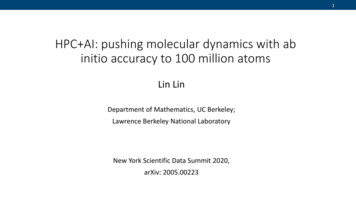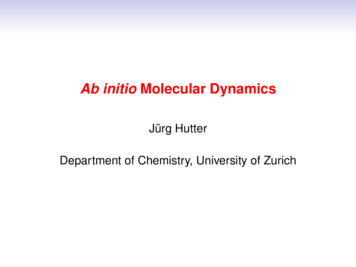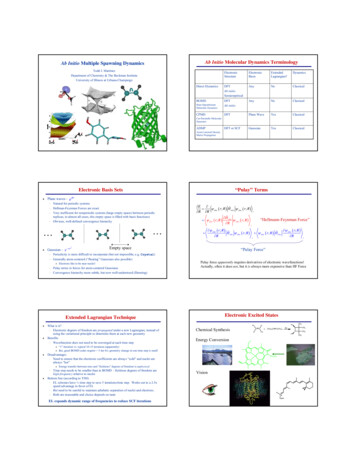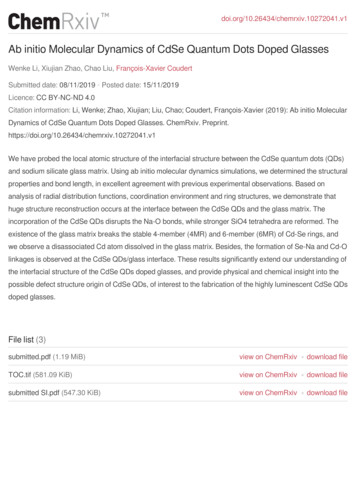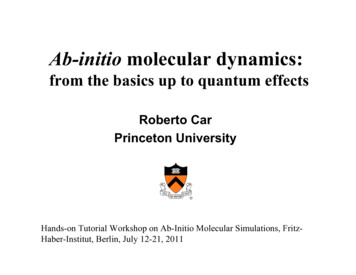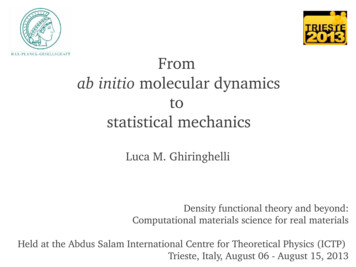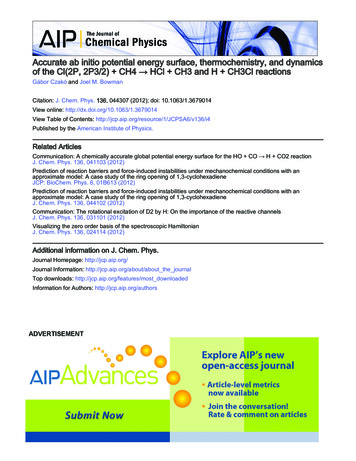
Transcription
Accurate ab initio potential energy surface, thermochemistry, and dynamicsof the Cl(2P, 2P3/2) CH4 HCl CH3 and H CH3Cl reactionsGábor Czakó and Joel M. BowmanCitation: J. Chem. Phys. 136, 044307 (2012); doi: 10.1063/1.3679014View online: http://dx.doi.org/10.1063/1.3679014View Table of Contents: hed by the American Institute of Physics.Related ArticlesCommunication: A chemically accurate global potential energy surface for the HO CO H CO2 reactionJ. Chem. Phys. 136, 041103 (2012)Prediction of reaction barriers and force-induced instabilities under mechanochemical conditions with anapproximate model: A case study of the ring opening of 1,3-cyclohexadieneJCP: BioChem. Phys. 6, 01B613 (2012)Prediction of reaction barriers and force-induced instabilities under mechanochemical conditions with anapproximate model: A case study of the ring opening of 1,3-cyclohexadieneJ. Chem. Phys. 136, 044102 (2012)Communication: The rotational excitation of D2 by H: On the importance of the reactive channelsJ. Chem. Phys. 136, 031101 (2012)Visualizing the zero order basis of the spectroscopic HamiltonianJ. Chem. Phys. 136, 024114 (2012)Additional information on J. Chem. Phys.Journal Homepage: http://jcp.aip.org/Journal Information: http://jcp.aip.org/about/about the journalTop downloads: http://jcp.aip.org/features/most downloadedInformation for Authors: http://jcp.aip.org/authors
THE JOURNAL OF CHEMICAL PHYSICS 136, 044307 (2012)Accurate ab initio potential energy surface, thermochemistry, anddynamics of the Cl(2 P, 2 P3/2 ) CH4 HCl CH3 and H CH3 Cl reactionsGábor Czakóa) and Joel M. BowmanCherry L. Emerson Center for Scientific Computation and Department of Chemistry,Emory University, Atlanta, Georgia 30322, USA(Received 26 October 2011; accepted 3 January 2012; published online 26 January 2012)We report a high-quality, ab initio, full-dimensional global potential energy surface (PES) for theCl(2 P, 2 P3/2 ) CH4 reaction, which describes both the abstraction (HCl CH3 ) and substitution(H CH3 Cl) channels. The analytical PES is a least-squares fit, using a basis of permutationallyinvariant polynomials, to roughly 16 000 ab initio energy points, obtained by an efficient compositemethod, including counterpoise and spin-orbit corrections for the entrance channel. This compositemethod is shown to provide accuracy almost equal to all-electron CCSD(T)/aug-cc-pCVQZ results,but at much lower computational cost. Details of the PES, as well as additional high-level benchmark characterization of structures and energetics are reported. The PES has classical barrier heightsof 2650 and 15 060 cm 1 (relative to Cl(2 P3/2 ) CH4 (eq)), respectively, for the abstraction andsubstitution reactions, in good agreement with the corresponding new computed benchmark values,2670 and 14 720 cm 1 . The PES also accurately describes the potential wells in the entrance andexit channels for the abstraction reaction. Quasiclassical trajectory calculations using the PES showthat (a) the inclusion of the spin-orbit corrections in the PES decreases the cross sections by a factor of 1.5–2.5 at low collision energies (Ecoll ); (b) at Ecoll 13 000 cm 1 the substitution channelopens and the H/HCl ratio increases rapidly with Ecoll ; (c) the maximum impact parameter (bmax )for the abstraction reaction is 6 bohr; whereas bmax is only 2 bohr for the substitution; (d) theHCl and CH3 products are mainly in the vibrational ground state even at very high Ecoll ; and (e) theHCl rotational distributions are cold, in excellent agreement with experiment at Ecoll 1280 cm 1 . 2012 American Institute of Physics. [doi:10.1063/1.3679014]I. INTRODUCTIONIn order to gain understanding of the dynamics of polyatomic bimolecular reactions in the gas phase, the reactions ofmethane with F and Cl atoms have been extensively studiedboth experimentally and theoretically.1–12 Following the earlywork on mode-specific dynamics of Cl methane, performedin the groups of Crim,2, 3 Zare,13 and Orr-Ewing,14 Liu and coworkers1, 7 carried out crossed molecular beam experimentsfor both reactions, where they have been able to measurethe correlated distributions of the product vibrational states.These experiments uncovered surprising results, namely, that(a) CH-stretching excitation enhances the DF CHD2 products in the F CHD3 reaction1 and (b) the CH-stretching excitation energy is no more effective to activate the late-barrierCl CHD3 reaction than the translational energy,7 contradicting the Polanyi rules.15The first-principles computations of the above-mentionedcorrelated distributions, as well as the simulations of theexperimental results, are challenging, but there has beenprogress toward accurate dynamical calculations for the Fand Cl methane reactions. In 2009 we developed a fulldimensional, ab initio potential energy surface (PES) for theF CH4 reaction,8 which was recently improved by developing an ab initio spin-orbit (SO) correction surface to thea) Author to whom correspondence should be addressed. Electronic 07/18/ 30.00PES.16 Quasiclassical trajectory (QCT) calculations8 on thisPES provided HF(v,J) ro-vibrational distributions in excellent agreement with experiments of Nesbitt and co-workers.17These results demonstrated the utility of QCT and the importance of an accurate PES. Furthermore, we found that the CHstretching excitation steers the slow F atom to the CD bondin the F CHD3 reaction supporting the above-mentionedsurprising experimental finding.1, 9 Very recently, we reporteda high-quality, full-dimensional, SO-corrected, ab initio PESfor the Cl CH4 reaction.18 Both the F and Cl CH4 PESsare permutationally invariant fits to high-level ab initio electronic energies obtained by efficient composite methods asdiscussed in detail in Sec. III.Since the first ab initio study19 of the Cl CH4 reactionpublished in 1989, several PESs have been reported for thisreaction describing the abstraction channel. In 1996 EspinosaGarcía and Corchado20 developed a semi-empirical PES byadjusting the parameters of an earlier H CH4 surface.21This PES was further improved in 2000 (Ref. 22) based onthermal rate constants and in 2006 (Ref. 23) using ab initiostationary point properties in addition to the measured thermal data. In 1999 Yu and Nyman24 reported the firstab initio PES using a three-degree-of-freedom model. In2007 Banks and Clary25 developed a two-dimensional (2D)ab initio non-SO PES and very recently in 2011 they reported PESs for all the SO states, again in a 2D model.26The first full-dimensional ab initio PES was developed in136, 044307-1 2012 American Institute of Physics
044307-2G. Czakó and J. M. Bowman2006 by Castillo et al.27 using Shepard interpolation andthe QCISD/aug-cc-pVDZ scaling-all-correlation level oftheory. Also in that year, Troya and Weiss12 reported aspecific reaction parameter (SRP) semi-empirical Hamiltonian (SRP-MSINDO) for the Cl CH4 reaction allowing efficient on-the-fly computation of the PES. In 2011Greaves et al.28 showed that another semi-empirical Hamiltonian (SRP-AM1), which was previously optimized for the Cl ethane reaction, can be used for the title reaction.Following our earlier work on F CH4 ,8 the presentCl CH4 PES development uses an efficient composite electronic structure method. Composite ab initio methods havebeen widely and successfully used for thermochemical29–32and spectroscopic33 applications; in this paper we demonstrate their utility for polyatomic reaction dynamics studies. As a result, this Cl CH4 PES incorporates (a) basisset effects up to aug-cc-pCVTZ (correlation-consistent polarized core-valence triple-zeta basis augmented with diffusefunctions);34 (b) electron correlation up to the “gold standard”CCSD(T) method;35 (c) the core-core and core-valence correlation effects; and (d) SO and counterpoise corrections forthe entrance channel. Furthermore, the present PES describesboth the major abstraction (HCl CH3 ) channel as well asthe high-energy substitution (H CH3 Cl) channel.Here, we report a detailed description of this PES andits ab initio characterization. The present study also providesnew ab initio benchmark values for the energetics of the title reactions. We focus especially on the wells in the entranceand exit channels and resolve the conflicting conclusions inthe literature regarding the well depth and its dependenceon the orientation of the reactants for the former well. Thebenchmark barrier heights and reaction energies are obtainedby the composite focal point analysis (FPA) approach,29, 30which considers a number of effects, such as (a) extrapolations to the complete basis set (CBS) limit using aug-cc-pVXZ[X 5, 6] bases, (b) electron correlation beyond CCSD(T),(c) core electron correlation effects, (d) scalar relativistic effects, and (e) SO corrections, which were routinely neglectedin previous studies.After presenting the benchmark structures and energeticsin Sec. II, we describe the computational details of the PESdevelopment in Sec. III. We show the accuracy of the composite method applied for the computation of roughly 16 000electronic energies. Then we give the details of the globalfit, which provides an analytical representation of the PESbased on polynomials that are invariant under permutationsof like atoms.36, 37 In Sec. III we demonstrate the accuracy ofthe PES by comparing the structures, energetics, and frequencies to the new benchmark values. In Sec. IV QCT calculations are reported for the Cl CH4 reaction, using the nonSO and SO-corrected PESs. We focus on two main aspects ofthe dynamics, which, to the best of our knowledge, have notbeen studied before. First, we investigate both the HCl CH3abstraction channel and the high-energy H CH3 Cl substitution channel. The latter has high barrier (14 720 cm 1 );thus, it is closed at low collision energies. We consider collision energies up to 20 000 cm 1 ; thus, we can calculate thebranching ratios of the H/HCl products. Second, we showthe effect of the inclusion of the SO correction in the PESJ. Chem. Phys. 136, 044307 (2012)by comparing reaction cross sections obtained on the non-SOand SO PESs. We also show a comparison between the computed and measured HCl rotational distributions and also givethe mode-specific vibrational energy distribution of the CH3product. Finally, a summary and conclusions are presented inSec. V.II. AB INITIO CHARACTERIZATIONA. Computational detailsThe benchmark electronic structure computationsemployed the augmented correlation-consistent polarized(Core-)Valence X Zeta basis sets, specifically the aug-ccpVXZ [X 2(D), 3(T), 4(Q), 5, 6] and aug-cc-pCVXZ [X 2(D), 3(T), 4(Q)] bases.38–40 For the single-referencecorrelation methods the reference electronic wave functionswere determined by the single-configuration restricted,as well as unrestricted, open-shell Hartree–Fock (ROHFand UHF) methods.41 For treating electron correlation weused the restricted and unrestricted open-shell second-orderMøller–Plesset perturbation theory (RMP2 and UMP2) (Ref.42) and the coupled-cluster (CC) (Ref. 43) methods includingall single and double (CCSD) and triple (CCSDT) excitationsas well as the CCSD(T) (Refs. 35 and 44) and CCSDT(Q)(Ref. 45) methods including perturbative triple (T) andquadruple (Q) terms. For open-shell systems the CC computations employ the ROHF-UCCSD and ROHF-UCCSD(T)formalism, whereas the post-UCCSD(T) computationswere performed based on UHF orbitals. The two differentformalisms provide the same energies within 1–5 cm 1 ;therefore, in the following text the UCCSD, UCCSD(T),etc. abbreviations will be used regardless of the referenceorbitals, which are precisely defined above. Finally, we notethat in this study FC denotes the use of the usual frozen-coreapproach for the electron correlation calculations, while AEmeans computations when all the electrons are correlated.All the electronic structure computations up toUCCSD(T), including geometry optimizations, harmonic frequency calculations, and single-point energy computations,were performed using MOLPRO.46 The MRCC program47, 48(interfaced to CFOUR (Ref. 49)) was employed for UCCSDTand UCCSDT(Q). Some of the large UCCSDT computations were performed by CFOUR. The scalar relativisticeffects were computed using Douglas–Kroll50 relativisticone-electron integrals as implemented in MOLPRO. Themulti-reference configuration interaction (MRCI Q) computations using the Davidson correction to estimate the effectof the higher order excitations ( Q) as well as the spin-orbitcalculations with the Breit–Pauli operator in the interactingstates approach51 were also performed by MOLPRO. TheseMRCI calculations utilized an active space of 5 electrons inthe 3 spatial 3p-like orbitals corresponding to the Cl atom.The benchmark relative energies were determined following the FPA approach.29, 30 The FPA employs the best reference structures, i.e., geometries obtained at AE-UCCSD(T)with aug-cc-pCVTZ, aug-cc-pCVQZ, and aug-cc-pCVQZ forthe barrier height, dissociation energy, and reaction enthalpycalculations, respectively. Single-point electronic structure
044307-3Potential and dynamics of the Cl CH4 reactionJ. Chem. Phys. 136, 044307 (2012)FIG. 1. Potential energy curves of CH4 –Cl as a function of the C–Cl distance along the C3v axis with fixed CH4 (eq) geometry and CH–Cl (upper panels) andHC–Cl (lower panels) linear bond arrangements computed at the frozen-core MRCI Q/aug-cc-pVTZ level (left panels) and all-electron CCSD(T)/aug-ccpCVXZ (X D, T, Q) level, where CP indicates the use of the counterpoise correction (middle panels). The right panels show the potential curves obtainedfrom the non-SO and SO-corrected ground state PESs. A1 and E denote the ground and excited non-SO electronic states, respectively, and SO1 , SO2 , SO3 arethe three spin-orbit states. The middle panels show the A1 state only at different levels of theory. The energies are relative to Cl(2 P) CH4 (eq). The data shownin the left and right panels were also reported in Fig. 2 in Ref. 18.computations were performed at the above-defined reference structures considering (a) extrapolations to the CBSlimit using aug-cc-pVXZ [X 5, 6] bases; (b) electron correlation beyond UCCSD(T) by performing UCCSDT/augcc-pVTZ and UCCSDT(Q)/aug-cc-pVDZ (in some casesUCCSDT(Q)/aug-cc-pVTZ) computations; (c) core electron correlation effects as difference between AE and FCUCCSD(T)/aug-cc-pCVQZ energies; (d) scalar relativistic effects at AE Douglas–Kroll UCCSD(T)/aug-cc-pCVQZ level;and (e) SO corrections obtained from the experimentallyknown SO splitting of the Cl atom.The ROHF energies, EXHF , and the electron correlationenergy increments, EXcorr. , obtained by the corresponding augcc-pVXZ basis set, have been extrapolated to determine thecorr.HFand ECBS, respectively, employing twoCBS limits, ECBS52, 53parameter formulas, HFEXHF ECBS a(X 1)e 9X(1)andcorr.EXcorr. ECBS bX 3 .(2)In order to get the best estimates for the CBS limits using theabove asymptotic formulas, the best two energies were usedin the extrapolations, which means the X 5 and 6 valuesup to UCCSD and X 4 and 5 for some of the UCCSD(T)energy increments.B. Entrance channel van der Waals regionFigure 1 presents the potential curves for the entrancechannel showing the van der Waals (vdW) well with CH–Cland HC–Cl C3v bond arrangements. There are contradictionsin the literature on the depth of this well. A study reportedthat the well at both configurations is about 100 cm 1 deep,12in disagreement with the present results. We found that asource of these contradictions is that two electronic statesare close to each other at this region (see Fig. 1, left panels) and a single-reference ab initio method can fail to converge to the right state. The present MRCI Q results showthat the excited electronic state has minima along the C3v axiswith CH–Cl and HC–Cl bond arrangements with depths ofabout 100 cm 1 for both, whereas the electronic ground stategives well depths of 100 and 300 cm 1 , respectively. Furthermore, the SO correction decreases the depth of the latter by100 cm 1 , but the HC–Cl vdW well still remains the deeperminimum. In order to benchmark the above energies we performed AE-CCSD(T)/aug-cc-pCVXZ [X D, T, Q] computations for the electronic ground state potential with and without counterpoise corrections for the basis set superpositionerror (BSSE). As Fig. 1 (middle) shows the aug-cc-pCVDZbasis provides too deep vdW minima due to the large BSSE;however, the computed counterpoise correction overestimatesthe BSSE and gives too shallow vdW region. As the basissize is increased to TZ and QZ we see that the potentials withand without BSSE correction converge to each other as seenin Fig. 1 (middle panels). We found very good agreement
044307-4G. Czakó and J. M. BowmanJ. Chem. Phys. 136, 044307 (2012)TABLE I. Structure (in Å and degrees) and classical barrier height (VSP , cm 1 ) for the abstraction saddle point (CH3 –Hb –Cl)SP at different levels of theory.Methodsar(CH)r(CHb )r(Hb Cl)α(HCHb 92577aFC and AE denote frozen-core and all-electron computations, respectively.between the benchmark AE-CCSD(T)/aug-cc-pCVQZ andthe MRCI Q/aug-cc-pVTZ ground state potentials, indicating that the presented MRCI Q potential curves are reasonably accurate for all the non-relativistic and SO states.C. The Cl CH4 HCl CH3 reactionThe structures of the first-order saddle point (CH3 –Hb –Cl)SP , complex in the product channel (CH3 –HCl), and thereactant and products computed at different levels of theoryare given in Tables I and II. The benchmark FPA results forthe classical barrier height, De of (CH3 –HCl), and reactionendoergicity are given in Tables III–V.The abstraction reaction has a late barrier, i.e., productlike structure, as seen in Fig. 2. Indeed, the C–Hb distance(1.397 Å) is significantly stretched by 0.309 Å relative tothe CH bond length in CH4 . The Hb –Cl distance is 1.443 Åat the saddle point, which is longer than the bond length ofthe HCl molecule by only 0.168 Å. The UMP2 method givesreasonable estimates for the saddle-point structure; it underestimates the C–Hb distance by about 0.05 Å and overestimates the Hb –Cl distance by about 0.01 Å relative to theUCCSD(T) results. The point-group symmetry of the saddle-point structure is C3v regardless the level of theory. Note thatfor F CH4 the saddle point has C3v symmetry at UMP2level, whereas the more accurate UCCSD(T) method givesCs saddle-point structure with α(C–Hb –F) 150 .8 This bentsaddle-point structure is unique for F CH4 among the halogen CH4 reactions, since our recent computations showedthat the Br and I CH4 reactions have collinear C3v saddle points,54 similar to Cl CH4 . Our best estimate for theclassical barrier height is 2670 40 cm 1 . (Note that theuncertainty is based on the results obtained at systematicallyincreased levels of ab initio method and basis as shown inTable III.) Electron correlation plays an important role in theaccurate determination of this key energy. The ROHF methodoverestimates the barrier by roughly 6600 cm 1 , UMP2 underestimates it by 400 cm 1 , and UCCSD overestimatesit significantly by 900 cm 1 . One has to employ at leastthe UCCSD(T) method to achieve reasonable convergence;the post-UCCSD(T) correlation contribution is only about 40 cm 1 based on the UCCSDT and UCCSDT(Q) computations. There is also a significant basis set dependence onthe barrier height. The aug-cc-pVXZ bases overestimate thebarrier by 340, 270, and 70 cm 1 for X D, T, and Q, respectively. The contributions of the core electron correlationTABLE II. Equilibrium structures (in Å and degrees) of the reactant, products, and the exit-channel complex (CH3 –HCl) as well as relative energies at differentlevels of theory for the Cl(2 P) CH4 HCl CH3 reaction.Cl CH4r(CH)r(CH)r(CHb )r(Hb 4abHCl CH3 (D3h )(CH3 –HCl) (C3v )MethodsaFC and AE denote frozen-core and all-electron computations, respectively.Dissociation energy (De ) of (CH3 –HCl) and the vibrationless enthalpy of the reaction ( Ee ) are given in cm 1 .α(HCHb )Debr(CH)r(HCl) Ee 1823
044307-5Potential and dynamics of the Cl CH4 reactionJ. Chem. Phys. 136, 044307 (2012)TABLE III. Focal-point analysis of the classical barrier height (VSP , cm 1 ) of the Cl(2 P3/2 ) CH4 HCl cc-pV5Zaug-cc-pV6ZCBSbVSP CSDT(Q)]VSP791780958086804580398038 5430 5826 6024 6089 6077 6059 981 1285 1321 1354 1359 1366 642 843 875 890[ 890] 906 29 16[ 16][ 16][ 16] 16 54[ 54][ 54][ 54][ 54] 54274426732470238223942402VSP (final) VSP (FC-UCCSDT(Q)/CBS) Core Rel. SO 2402 21 6 294 2669aThe results correspond to the structures optimized at the all-electron UCCSD(T)/aug-cc-pCVTZ level of theory. The symbol δ denotesthe increments in VSP with respect to the preceding level of theory. Brackets signify assumed, non-extrapolated, increments from smallerbasis set results. Previously published as Table S2 of Ref. 18. The bold numbers are the final FPA results with and without smallcorrections (core, relativistic, and SO).bThe complete basis set (CBS) ROHF energy and the RMP2, UCCSD, and UCCSD(T) electron correlation energies were calculatedusing two-parameter extrapolation formulae given in Eqs. (1) and (2), respectively. Only the best two energies were included in theextrapolations.and scalar relativistic effects are small, 21 and 6 cm 1 ,respectively. However, the SO effect is significant, since it effectively increases the barrier by 294 cm 1 . We took all theabove effects into account; thus, we arrived to the new benchmark value for the classical barrier height (2670 40 cm 1 ).(Note that a recent study28 reported a classical barrier heightof 2385 cm 1 obtained at CCSD(T)/CBS//CCSD(T)/aug-ccpVTZ, which value is slightly smaller than our more rigorous CCSD(T)/CBS value of 2440 cm 1 and much smallerthan our benchmark value of 2670 cm 1 . The difference inthe CBS value is due to the fact that Ref. 28 extrapolatesfrom TZ and QZ results, whereas we use more accurate 5Zand 6Z energies to determine the CBS limit. The main reasonof the large difference between the final benchmark values isthat Ref. 28 neglects the SO effect.) Furthermore, applyingharmonic zero-point energy (ZPE) correction we get the final vibrationally adiabatic ground state barrier height of 1200 200 cm 1 , whose larger estimated uncertainty is due to theuncertainty of the ZPE correction, especially the effect of thevibrational anharmonicity.The well in the product channel, of C3v symmetry, hasequilibrium C–Hb and Hb –Cl distances of 2.236 and 1.284 Å,respectively, obtained at the AE-UCCSD(T)/aug-cc-pCVQZlevel of theory. The latter is just slightly longer than the bondlength of the HCl molecule (1.274 Å). As Table IV shows, theFPA analysis of the De is well converged; the post-UCCSD(T)correlation effect is only 5 cm 1 . The aug-cc-pVXZ baseswith X D, T, Q, 5, and 6 overestimate the De by 134, 87,46, 26, and 13 cm 1 , respectively, relative to the CBS limit.After applying the minor correction for core electron correlation ( 9 cm 1 ) and the scalar relativistic effect ( 14 cm 1 ),the final accurate De is 820 10 cm 1 . We expect this relatively deep well to affect the product state distributions, especially the rotational and angular distributions. In Fig. 3 thevariation of the potential of this well is shown as a functionof the C–Cl–Hb angle keeping all other coordinates fixed attheir equilibrium values. As seen, there is a fairly steep dependence on this angle, indicating a significant orienting force forthe collinear C–Hb –Cl configuration. More discussion of thedynamical effects of this hindering is given in Sec. IV. Also,because this well is much deeper than the entrance channelone, it is of interest to investigate whether it supports a boundstate. We estimate this using the harmonic ZPE. Based on that,we estimate D0 to be 350 50 cm 1 . We do not report asimilar harmonic analysis for the entrance channel well because the motion in that shallower well is likely much moreanharmonic than the exit channel one. Thus, we believe that aharmonic analysis of whether there is a bound state in theTABLE IV. Focal-point analysis of the dissociation energy (De , cm 1 ) of the exit-channel complex (CH3 V5Zaug-cc-pV6ZCBSbDe CSDT(Q)]De18 39 61 74 78 78 948 974 962 957 946 931 164 196 207 210 208 206 120 140 144 145[ 145] 146 4 1[ 1][ 1][ 1] 1 6[ 6][ 6][ 6][ 6] 6932885844824811798De (final) De (FC-UCCSDT(Q)/CBS) Core Rel. SO 798 9 14 0 821aThe results correspond to the structures optimized at the all-electron UCCSD(T)/aug-cc-pCVQZ level of theory. The symbol δ denotesthe increments in De with respect to the preceding level of theory. Brackets signify assumed, non-extrapolated, increments from smallerbasis set results. The final FPA result was previously published in Ref. 18. The bold numbers are the final FPA results with and withoutsmall corrections (core, relativistic, and SO).bThe complete basis set (CBS) ROHF energy and the RMP2, UCCSD, and UCCSD(T) electron correlation energies were calculatedusing two-parameter extrapolation formulae given in Eqs. (1) and (2), respectively. Only the best two energies were included in theextrapolations.
044307-6G. Czakó and J. M. BowmanJ. Chem. Phys. 136, 044307 (2012)TABLE V. Focal-point analysis of the vibrationless endoergicity ( Ee , cm 1 ) of the Cl(2 P3/2 ) CH4 HCl cc-pV5Zaug-cc-pV6ZCBSb Ee CSDT(Q)] Ee303227952691257725562551 748 837 980 1029 1021 1010 244 439 409 416 413 408 89 149 156 163 164 166 5 18[ 18][ 18][ 18] 18 20 26[ 26][ 26][ 26] 26241422401956179417761775 Ee (final) Ee (FC-UCCSDT(Q)/CBS) Core Rel. SO 1775 18 40 294 2091aThe results correspond to the structures optimized at the all-electron UCCSD(T)/aug-cc-pCVQZ level of theory. The symbol δ denotesthe increments in Ee with respect to the preceding level of theory. Brackets signify assumed, non-extrapolated, increments from smallerbasis set results. The final FPA result was previously published in Ref. 18. The bold numbers are the final FPA results with and withoutsmall corrections (core, relativistic, and SO).bThe complete basis set (CBS) ROHF energy and the RMP2, UCCSD, and UCCSD(T), electron correlation energies were calculatedusing two-parameter extrapolation formulae given in Eqs. (1) and (2), respectively. Only the best two energies were included in theextrapolations.D. The Cl CH4 H CH3 Cl reactionThe structures of the first-order saddle point (Hb –CH3 –Cl)SP (see Fig. 2) and the reactant and product moleculescomputed at different levels of theory are given in Table VI.The benchmark FPA results for the classical barrier heightand reaction endoergicity are given in Tables VII and VIII,respectively.At the saddle point the C–Hb distance is 1.540 Å, i.e.,significantly stretched relative to the CH bond length of CH4(1.087 Å). The C–Cl distance (2.014 Å) is longer by 0.230 Åthan that of the CH3 Cl product. The saddle-point structure isalready inverted, since the α(H–C–Cl) bond angle is 97.0 ,i.e., larger than 90 , though less than the same bond angle inCH3 Cl (108.4 ). The classical barrier height for the substitution reaction is 14 720 80 cm 1 , a much higher barrierthan that of the abstraction reaction. The basis set effect onUCCSD(T)/aug-cc-pVTZPES1000Energy / cm 1shallow entrance channel well would be too unreliable toreport.The abstraction reaction endoergicity is 2090 20 cm 1relative to Cl(2 P3/2 ) CH4 (eq). In order to achieve this highaccuracy, significant basis set effects as well as the SO correction were taken into account. The aug-cc-pVXZ bases withX D, T, Q, 5, and 6 overestimate the reaction endoergicity by 639, 465, 181, 19, and 1 cm 1 , respectively, relativeto the CBS limit. This shows good convergence to the CBSlimit; however, it is important to note the poor performanceof the DZ and TZ (even QZ if high accuracy is aimed) bases.The SO correction has an effect of 294 cm 1 on the endoergicity. Furthermore, the scalar relativistic effect is also notnegligible, since it is 40 cm 1 . If we take the significantanharmonic ZPE correction ( 1730 cm 1 ) into account, wearrive at the final 0 K reaction enthalpy of 360 30 cm 1 .(Note that the harmonic ZPE correction ( 1820 cm 1 )
THE JOURNAL OF CHEMICAL PHYSICS 136, 044307 (2012) Accurate ab initiopotential energy surface, thermochemistry, and dynamics of the Cl(2P, P3/2) CH 4 HCl CH 3 and H CH 3Cl reactions Gábor Czakóa) and Joel M. Bowman Cherry L. Emerson Center for Scientific Computation and Department of Chemistry,

